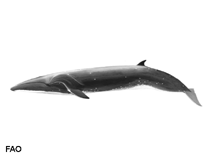Balaenoptera borealis Lesson, 1828
Sei whale| Native range | All suitable habitat | Point map | Year 2050 |

|
| This map was computer-generated and has not yet been reviewed. |
| Balaenoptera borealis AquaMaps Data sources: GBIF OBIS |
Classification / Names Common names | Synonyms | CoL | ITIS | WoRMS
Mammalia | Cetartiodactyla | Balaenopteridae
Environment: milieu / climate zone / depth range / distribution range Ecology
Pelagic; depth range 0 - 342 m (Ref. 116169). Tropical; 8°C - 25°C (Ref. 75906); 90°N - 90°S, 180°W - 180°E
Distribution Countries | FAO areas | Ecosystems | Occurrences | Introductions
Circumglobal: Balaenoptera borealis borealis: Greenland, Iceland, Norway, North Carolina, Bay of Biscay, Mediterranean Sea, South Carolina, Gulf of Mexico, Bay of Campeche, Caribbean Sea, Cuba, Anguilla, Morocco, Mauritania, Alaska, Bering Sea, Gulf of Alaska, Japan, Southern California, Ogasawara, Mexico, Islas Revilla Gigedo (Pacific Ocean); Balaenoptera borealis schlegellii: Antarctica, Brazil, Angola, South Africa, Western Australia, Cook Straits, New Zealand, Peru, Java Indonesia (Ref. 1522).
Length at first maturity / Size / Weight / Age
Maturity: Lm 1,330.0 range ? - ? cm Max length : 1,800 cm TL male/unsexed; (Ref. 1394); max. published weight: 30.0 t (Ref. 1394)
Life cycle and mating behavior Maturity | Reproduction | Spawning | Eggs | Fecundity | Larvae
Main reference
References | Coordinator | Collaborators
Jefferson, T.A., S. Leatherwood and M.A. Webber 1993 FAO species Identification Guide: Marine Mammals of the World. Rome, FAO. 320 p. + 587 figures. (Ref. 1394)
IUCN Red List Status
(Ref. 130435: Version 2025-1)
CITES status (Ref. 108899)
CMS (Ref. 116361)
Threat to humans
Human uses
Fisheries: commercial
FAO - Fisheries: landings, species profile | FishSource | Sea Around Us
Tools
More information
Max. ages / sizes
Length-weight rel.
Length-length rel.
Length-frequencies
Mass conversion
Abundance
Internet sources
BHL | BOLD Systems | CISTI | DiscoverLife | FAO(Fisheries: species profile; publication : search) | Fishipedia | GenBank (genome, nucleotide) | GloBI | Gomexsi | Google Books | Google Scholar | Google | PubMed | Tree of Life | Wikipedia (Go, Search) | Zoological Record



